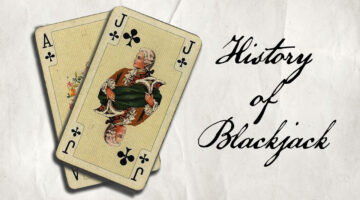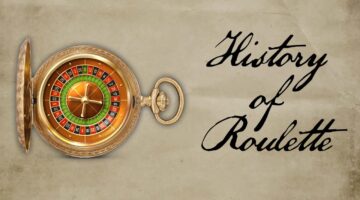Medieval Gambling Exploration: How People Played Games of Chance in the Middle Ages
- By: Sean van der Merwe on September 25, 2021
- Categories: Gaming
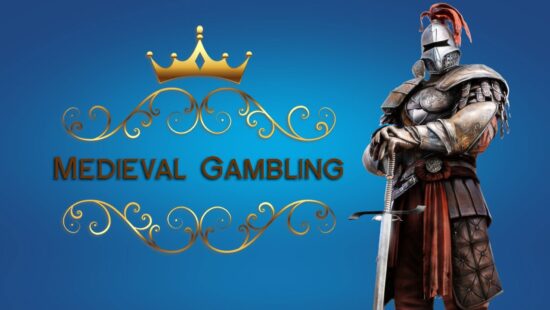
The world today is a very different place from the world that existed even one hundred years ago. The evolution of life and society is ever-morphing because of advancements in knowledge, education, and technology, to name a few things. Those old enough to live in different decades can even trace how rapid this change has been in such a short period of time. Now, just imagine the differences observed between now and half a millennia ago. Well, that’s what we want to explore in this article on medieval gambling.
Some things remain the same, no matter how many years pass. One such characteristic of human nature is the drive to take risks and gamble. As the old adage says – “Life is a Gamble”. However, there are those in society that prefer to raise the stakes beyond the norm in the name of entertainment.
The gambling industry has fed off this persistent nudge of the human heart and is actually one of the fastest evolving markets on the globe at present. The Rise of iGaming in the USA right now is a big testament to this fact. The invention of the internet has made this type of entertainment super popular. Now, players around the world have access to thousands of different games to take a chance on and win money along the way.
But was gambling always this popular? We want to take a time-warp back to the Middle Ages; to a time when technology and education seemingly stood still, according to many historians. It would be interesting to observe if medieval gambling was showing any similar patterns to what we observe in the industry today. Join us, as we take an in-depth dive into the medieval gambling era.
A Brief History of Gambling
Gambling is no new thing. In fact, it manages to transcend the scope of written history. Dice throwing, for instance, dates back to ancient Mesopotamia, around 3,000BC. There is, however, solid evidence that even cruder gambling paraphernalia, called Astragali, stretch back thousands of years before that even.
As such, we believe that it is safe to say, that people have gambled in one way or another since the inception of humankind. We, as a race, are obviously just natural chance-takers. But this is not a bad thing, within the correct context, as very few people would be successful in life without taking chances from time to time.
It’s clear that advanced societies, such as the Ancient Greeks and Romans, commonly practiced the art of the gamble. In fact, records from the Christian Bible portray Roman soldiers casting lots (throwing dice) for the chance to win Jesus’ apparel while they were crucifying Him (Matthew 27:5). In Rome, gambling eventually got so out of hand that the authorities had to ban it.
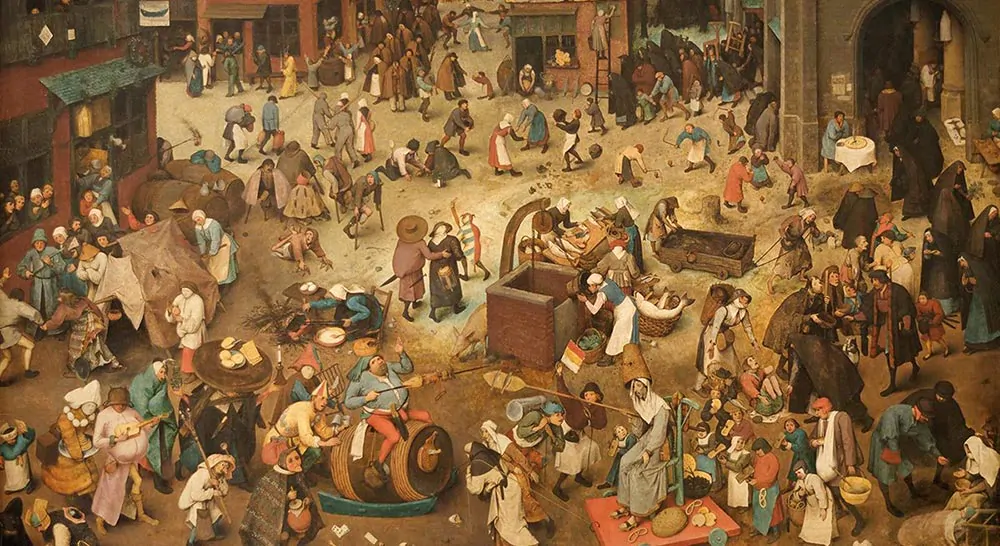
“The Combat between Carnival and Lent” by Pieter Bruegel the Elder, 1559. A painting of day-to-day life during Medieval Times.
The Middle Ages Under the Microscope – What was life like in this era?
The Medieval/Middle Ages was an era where smaller kingdom domains ruled most of Europe, Asia, and Africa from about 500 to 1500 AD. This period immediately followed the fall of the Roman Empire in 476 AD. As a result of the dissolution of Rome, various regions formed kingdoms to govern and protect the people from the lawlessness that was ever-increasing at the time. As a result, it was an unsettling era where much strife existed between kingdoms and countries.
It is in the Middle Ages that the tales of heroic knights and legendary kings come to the fore. Perhaps none are as well known as King Richard, the Lionheart, or King Arthur. Though King Arthur is more a legend than a historical figure, the stories of Camelot and Avalon have shed light on what it must have been like to live in this feudalistic time period.
A Dark, Dark Place
The Middle Ages has often been referred to as the “Dark Ages”. It was a label first coined by an Italian scholar by the name of Francesco Petrarch who lived between 1304 and 1374. Many historians believe that the Ancient Greek and Roman Empires were really advanced for their time, contributing heavily towards the advancement of humankind and society. Some maintain that the fall of Rome plunged the world into a Dark Age where science, philosophy, architecture, and more stagnated for around 1,000 years.
Few modern scholars use the term today though, citing the fact that the 15th Century was not as dark as was once made out. One thing we do know though, is that the era was certainly not without its challenges.
Sanitation was an issue throughout medieval times. According to the Britannica Encyclopaedia, the age began with the Plague of 542 and ended with the Bubonic Plague (Black Death) of 1348. But it doesn’t stop here, for throughout history recorded at this time, people where troubled with diseases such as leprosy, smallpox, tuberculosis, scabies, anthrax, trachoma, dancing mania, and more.
Living conditions were never the best and there was a huge chasm between the rich and the poor. The feudalistic governmental regime made certain that there was little hope for the poor to improve on their condition at all.
Medieval Gambling – Entertainment to Brighten the Dark
The picture of medieval times shown above represents a sad and stagnant world, yet even during a time such as this, medieval gambling found a place. If there is one thing that mankind has proven repeatedly, it’s that no trials and tribulations will get in the way for the need for entertainment.
While casinos and traditional casino games found no place among the culture of the day, taverns and inns became hotspots for gambling. This was much to the disdain of the Roman Catholic Church, which incessantly tried to quash the pastime without much luck.
It must be hard to try and outlaw a pastime that was practiced freely among the nobles in the royal courts. Of course, the stakes were much higher among the wealthy, but medieval gambling was rife among people of all classes, including ship captains, sailors, journeymen, and everyone in between.
Medieval Gambling Laws and Traditions
The laws on gambling varied vastly from region to region. It was becoming apparent that unregulated gambling was causing issues. Violence and immorality were beginning to become an attached stigma to this type of ‘risky’ entertainment.
In most Livonian towns (between 1440 and 1525), the church and civic authorities banned gambling (dobbelspil). Players caught contravening the laws could receive stiff fines, with the severity of the penalty depending on where they were found playing.
In other regions, there was an allowance for gambling, with restrictions on “Holy Days”. But in most kingdoms, the severest punishments were metered out on cheaters. While some laws would allow the branding of cheaters for their atrocities, other regions would sentence the perpetrator to death, depending on the severity of their con.
According to folklore and legend, dice cheaters found with weighted dice would have their palms pierced with their own dies. The traditional medieval gambling dice is a lot smaller and sharper than those of today, making it far easier for the authorities to imbed it into the hands of the cheater. This would serve as a permanent warning to the public not to gamble with such a branded ‘rascal’.
It wasn’t uncommon for ‘’dice men’’ to weight their cubes. A Fordham University article reported that the Museum of London recovered 24 bone-carved cubic die from the medieval gambling period. They were found along the shores of the Thames, inside a birdseed pot. All cubes were X-rayed, revealing that 18 of the die contained mercury weights. These cheating dies are known as Fulham Dice. Their existence is a testament to the fact that cheating was apparent back then.
Top Medieval Gambling Games
Walk into a land-based casino today and walk across the floor and you will find that there are so many different games that you can play. There’s roulette, blackjack, slot machines, poker, video poker, baccarat, craps, and so much more. While many of these games (bar the electronic ones) have been around for a long time, none of them were prevalent in the medieval gambling taverns.
The people of the day had unique game options that were distinct to the time period. Just a glance over the list may have even the biggest modern gaming enthusiast scratching their heads in confusion.
Have you ever heard of Zara, Glückshaus, Raffle Passage, Hazard, Karnöffel, Rithmomachy, Alquerque, Mill, Cross and Pile, Thimble Rig, or Nine Men’s Morris? Well, these are only some of the popular games of the age. Archaeologist and historian, Zsuzsanna Söregi, who is an expert in Medieval times, suggests that medieval gambling fans had more game types at their disposal back then than we have in our modern casinos today.
For the sake of interest, we will explore some of the most popular games played back then in this article. To do this, we will divide the game options into four categories on the page, namely dice games, card games, other games, and sports betting options. We will then list the top three games in each of the first three categories and then go on to explain what sports were popular to bet on among medieval gambling enthusiasts.
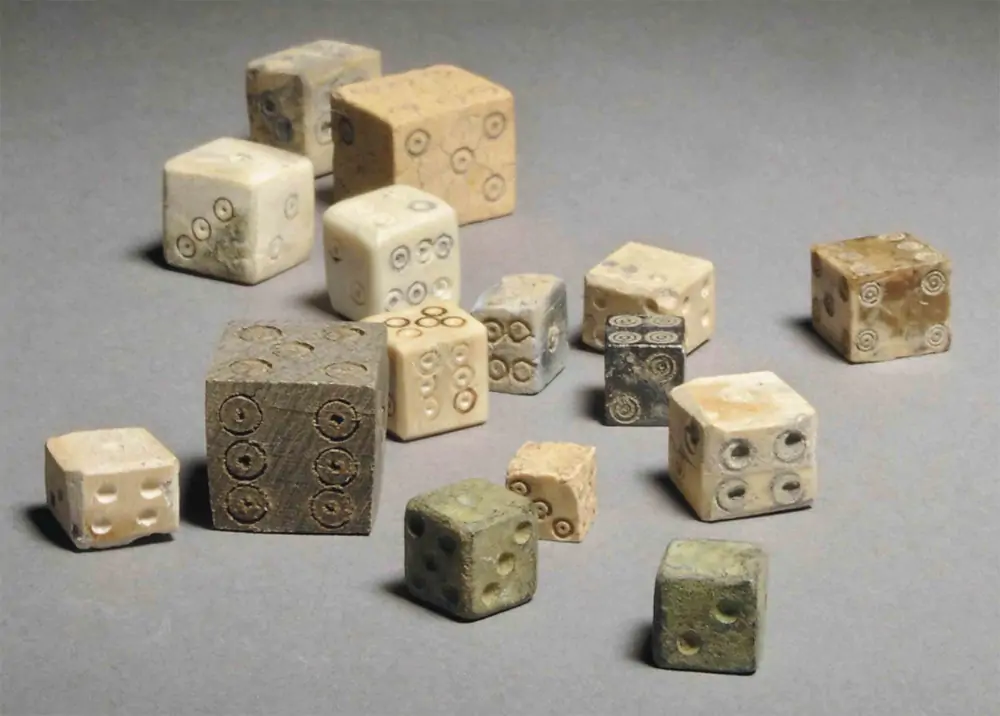
Medieval Dice Options. Image courtesy of Christies.com (Ancient Dies on Auction).
Dice Games
Dice games were probably the earliest form of medieval gambling enjoyed in the 15th Century. They formed dies from bone, metal, and wood. According to early manuscripts, bone dies were most sought-after because they would fall more squarely on any type of surface.
Because dice rolls provide randomly natural outcomes (unless weighted), it only seems logical that they would make the best chance-based medieval gambling accessory. Below are three popular medieval dice games enjoyed by the gambling public hundreds of years ago:
1. Glückshaus (House of Luck)
This medieval gambling game plays out with multiple players, 2 dice, and a game board with segments numbered from 2 to 12 on it. Bettors place coin wagers on the various segments on the board. Rolling specific numbers from the dice rolls determines what happens to the different wagers placed on the board.
2. Hazard
Many of you might be familiar with this word. That’s because ‘Hazard’ is the forebearer of the modern craps game. Its rules are rather complicated, but it still proved to be a mighty popular game from the 14 Century right up until the late 18th Century.
3. Passe Dix
We spoke earlier of gambling mentioned in the Holy Bible. Many sources believe that the Romans were playing Passe-Dix at the time of Christ’s death. The game plays out traditionally with three dice. There is a banker and unlimited players. The banker will change with each game round.
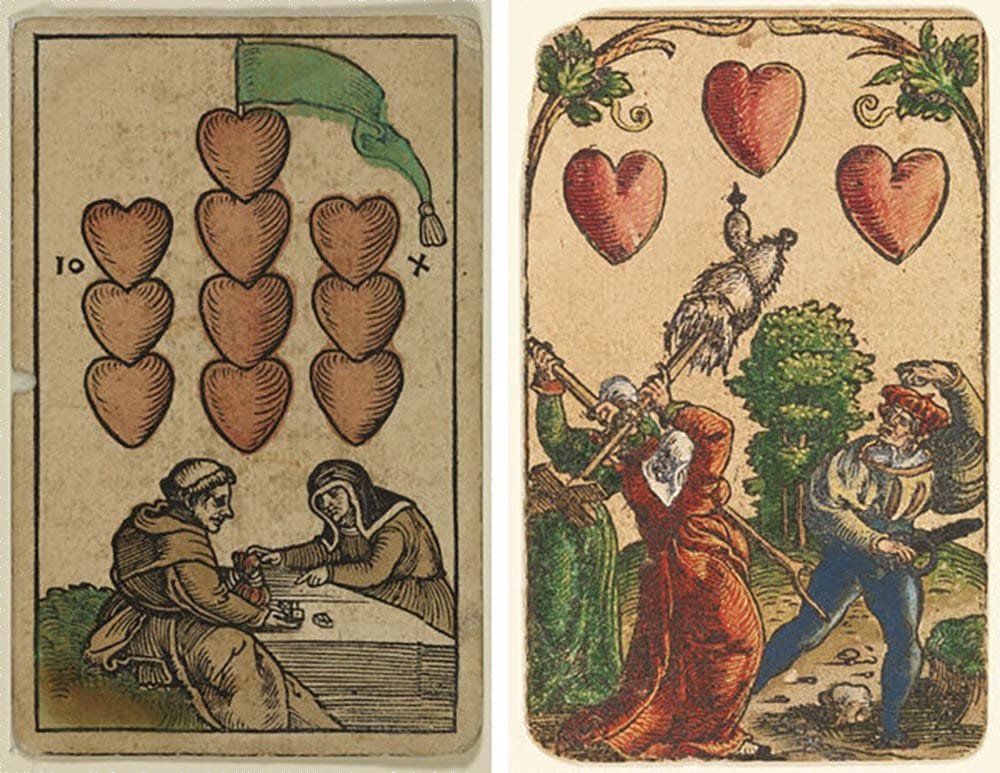
Traditional Medieval Playing Cards. 10 of hearts was from the playing cards of Hans Schäufelein, 1535. The 3 of hearts was from the playing cards of Peter Flötner, 1540. Both images are courtesy of the Germonisches Museum.
Card Games
In the middle of the 15th Century, Asians introduced playing cards to Europe. The new medieval gambling paraphernalia would soon overtake dice games at taverns, introducing multiple card games for entertainment, instead.
The first cards displayed symbols quite different from today’s spades, clubs, hearts, and diamonds. In fact, the first known card icons showcased a sabre, cudgel, coin, and chalice. As with all things, cards went through several evolutions before arriving at our present-day card decks.
Here is a list of three popular card games played in the Middle Ages:
Karnöffel
This game originates from Germany in the early 15th Century and is the oldest identifiable European card game. It is a trick-taking card game played with a traditional 48-card German deck. The game plays out with four players divided into two teams of two. Players need to out-trick their opponents by trumping their cards of the same suit. The winner at the end of the game takes the stake.
Triomphe
This game dates to the late 15th Century. It most probably originates from either Spain or France. The game plays out with four players (single or partnered). Players need to present cards from their hands that match the suit of the card played on the table. Players stake between each trick.
Bete
This is a derivative of Triomphe which makes placing bids/wagers far easier. This game became very popular and lasted into the 16th and 17th Centuries. It was usually played for small stakes, but there really is no limit to the betting options with this title.
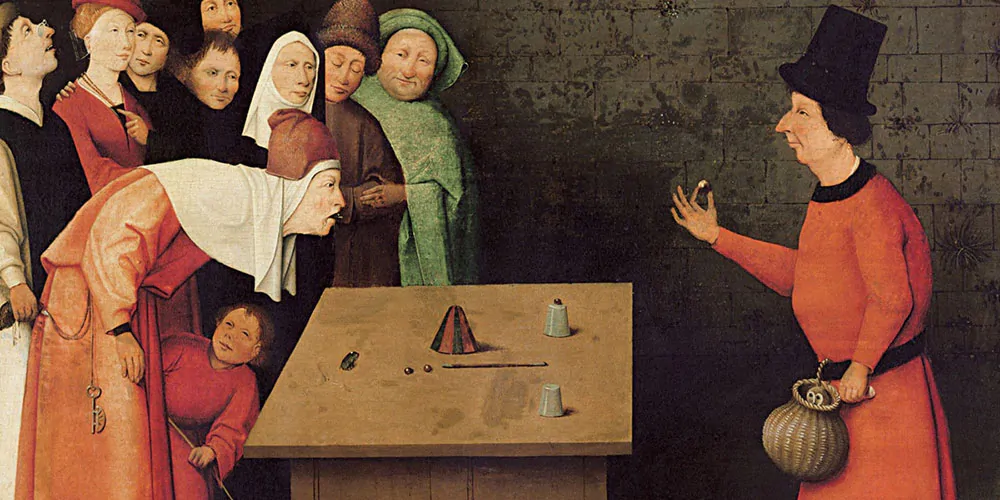
“The Conjurer” by Hieronymus Bosch, 1502. A painting depicting the Middle Ages game of Thimble Rig.
Other Games
Like today, Medieval gambling options were plentiful. As such, there are some games that make it into a miscellaneous category. Join us, as we explore three of these fine titles below. Two of them, you may be familiar with, as they are still used in various ways today, just not at casinos.
Thimble Rig
Thimble Rig was a game for scammers on the medieval streets. The game involves three cups or thimbles and a pea/ball. A player would pay to take on the scammer and attempt to win a prize for guessing which thimble the pea was under after they were shuffled. The game involves sleight of hand, which means that the house ALWAYS won.
Cross and Pile
Most people today are familiar with this game without realizing it. Cross and Pile is just another version of heads or tails. Medieval gambling bettors would place wagers on what side of the coin would land face-up after being flipped.
Nine Men’s Morris
This was a 2v2 strategy game with a similar goal to that of checkers/draughts. If both parties were privy to the perfect strategy, the game would result in a draw every time. The aim of the game was to line up three of your pieces in a line while reducing your opponent to 2 pieces on the board.
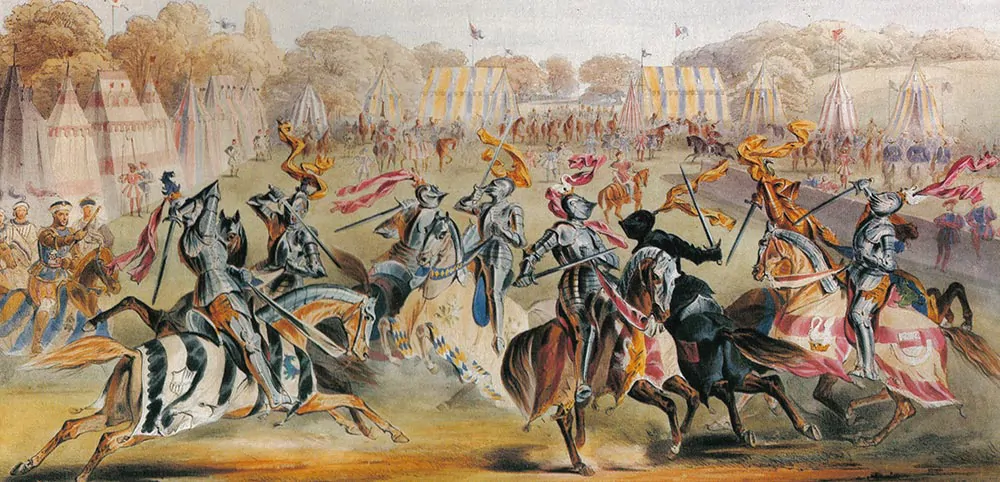
“The Melee, Eglington Tournament” by James Henry Nixon, 1839. A painting of a Medieval Sports Tournament.
Medieval Gambling on Sports
Whenever men and women get competitive on the sports front, there are other men and women ready to get in on the action in the background. Such is the entertainment available when sports betting. Like at sportsbooks today, bettors line up to wager on the odds of their favorite sports matches and events. This is a pastime handed down from ancient history. The only difference now is that the sports have changed.
In the Middle Ages, sporting events were quite different from today. Medieval sports were distinctive. These sports included many of the “knightly” events of the day, such as jousting, hammer throw, archery, and more.
Gambling Today
The contrast between Medieval gambling and the modern-day industry is massive. Of course, technology has played a big part in innovation. The internet has made the world a much smaller place, which means that it is far easier to provide fair and fun gaming to a wider audience.
Innovation aside, it has been evident for hundreds of years that regulation is necessary to maintain a safe gaming environment for those underaged and who struggle with gambling addictions. Where some have failed in their ability to implement laws and enforce them, others have succeeded.
We are at a point now where there is absolutely no reason for problem gaming to persist nor unfairness to be a problem when you go online for a gamble. All the regulatory bodies, certification companies, and software testing organizations involved in the process make the gambling space a much safer and fairer place to be.
Medieval gambling is a milestone market that showcases just how far the industry has come over the centuries. While gambling is still often scorned by sections of society for various reasons, we cannot ignore the fact that regulators are tightening their grip on the market to ensure that it is ethically managed and is as safe as possible for all involved. It goes to show that time teaches us great lessons. When we learn them well and implement changes, it can pay off.



